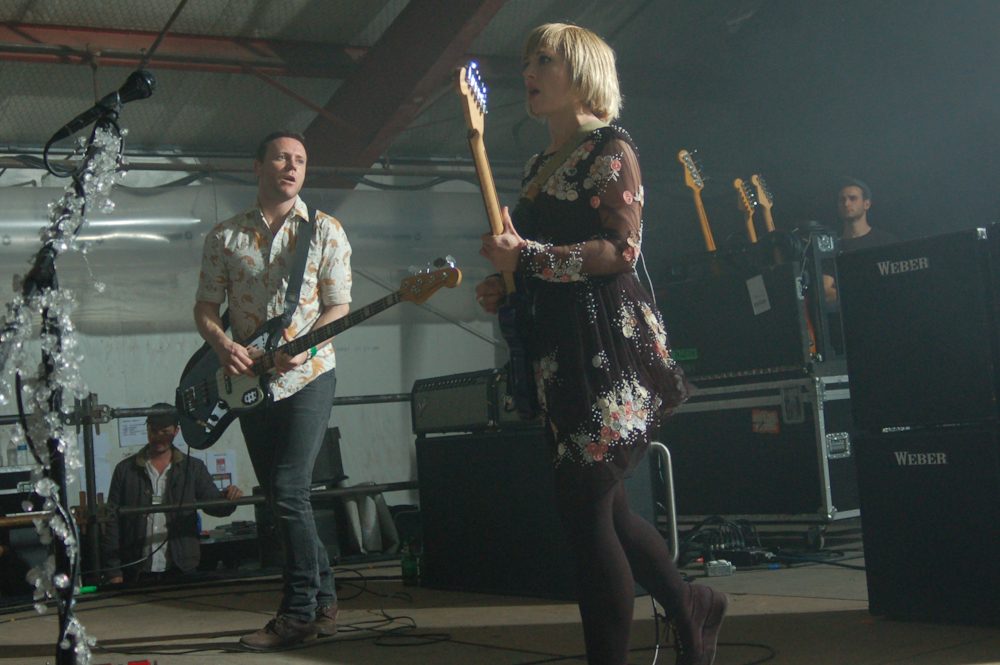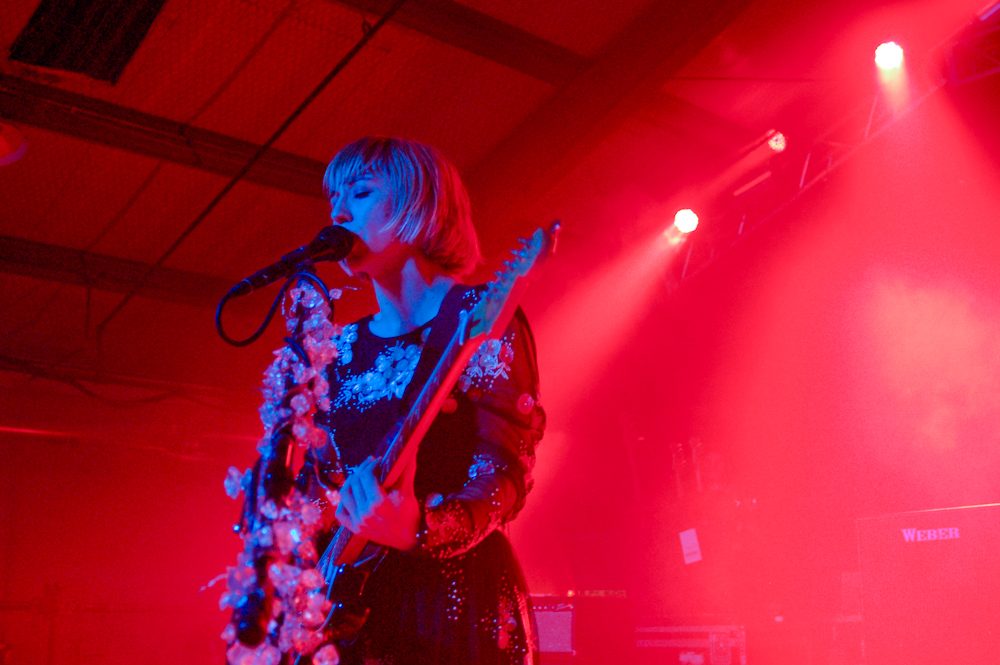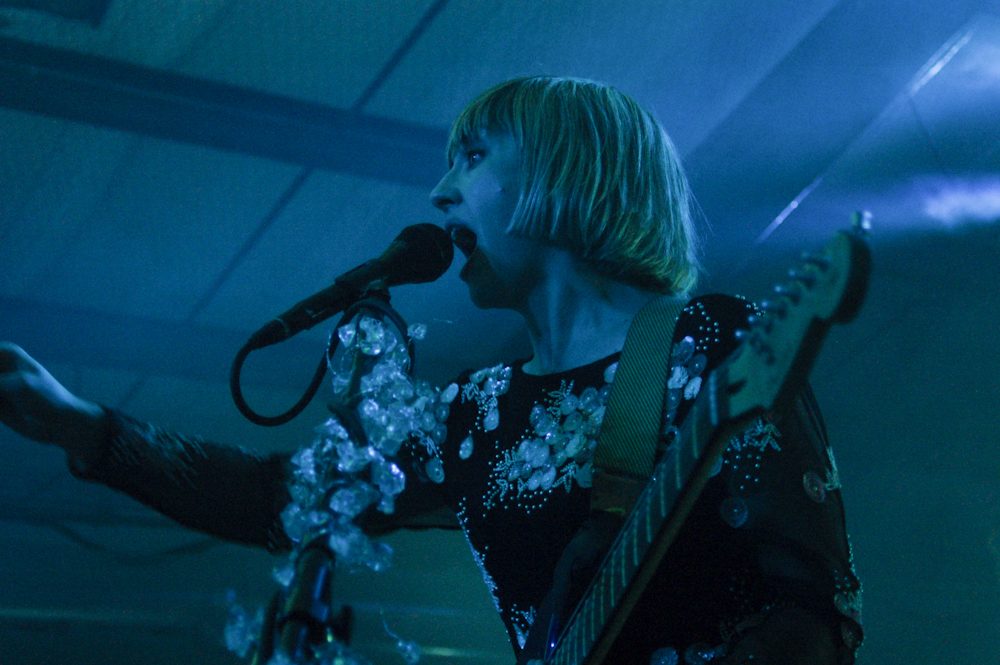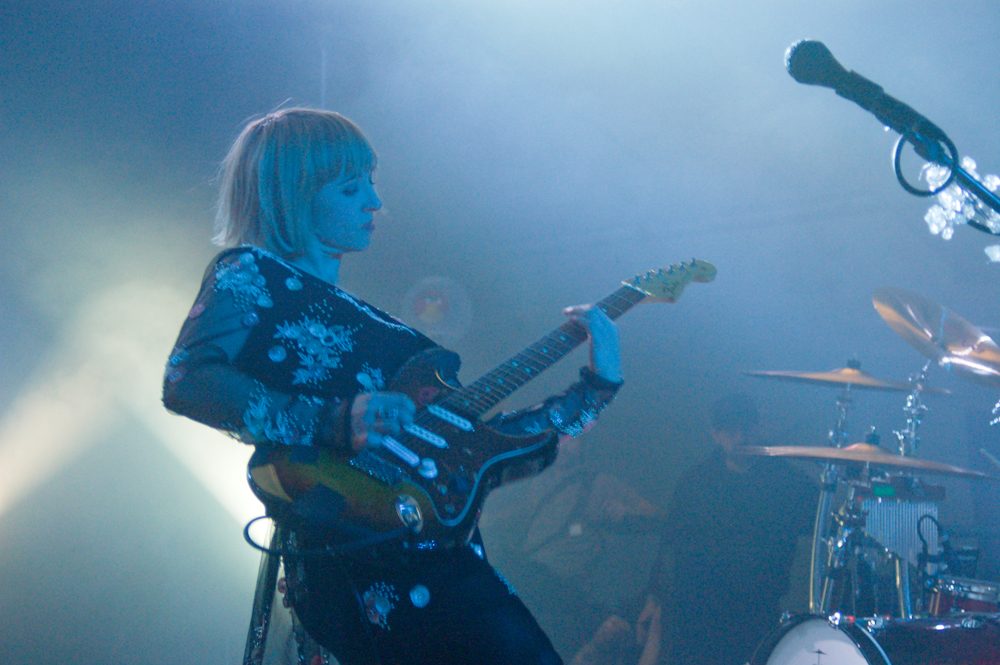

The Joy Formidable are a UK band formed in 2007 from the North of Wales. Following the band’s first LP The Big Roar and the buzz surrounding that record, with significantly radio play for the single “Whirring,” the band has grown within sound and fanbase to be a formidable presence within the rock realm, pun intended. They can hover under the radar, but as soon as you hear them, it’s like they’ve been your favorite band for years. Their newest record AAARTH (Welsh for bear) is part of the growth pattern where they have utilized more tribal drums and focus on guitar, seen on the first two singles “Dance of the Lotus” and “The Wrong Side.”
The Joy Formidable used the backdrop of the American West, with an affinity for Utah, to drive the record’s inspiration and make the music pop in a mystical experience of symbols, cultures and color. mxdwn had the opportunity to talk with bassist and founding member Rhydian Dafydd Davies to discuss the new record, a sort of rebirth for the band with writing and recording in Utah and the allure of their home country of Wales.
mxdwn: The Joy Formidable has been very busy lately on tour and with a new record coming out called AAARTH, on September 28th, can you discuss the origins of the record and what the title of the record means?
Rhydian Dafydd Davies: I think we started writing about 18 months ago and we’ve had a pretty traumatic time towards the end of the last record and little but after that. There was definitely a period where we rediscovered ourselves, and [then] losing ourselves in music again. After a little bit of that trauma, we really found ourselves re-energized and we began to see the band as colorful and full of life, with a lot of energy.
We started to get going on about a year ago. I think we recorded this one a lot differently than the other albums. It’s pieced together more like a collage. We’ve always done multi-layered things with some denseness. But this one is a lot more fleeting, and a collage effect. We really liked experimenting and toying with a different approach to piecing songs together. It still very much has a songwriter view and craft to the writing, but how it was put together was extremely different. We used real drums, but also pieced together samples off of actual playing. We fucked around a lot with the guitars and pre-amps and we wanted to celebrate the guitar and the tones you can get from it, but also doctoring it in the mix down period. We mixed it ourselves, which we’ve always done, it went hand in hand with the entire record.
We wrote most of the record in Utah and the colorful elements from the record comes from the surrounding landscape. The night sky in Utah is so huge here and so vivid and colorful. And it has a very mystical element to the landscape as well, which runs through the record as well. I don’t know if it was a need to escape with some of what was going on when we were writing, but we almost feel like it’s a psychedelic rebirth you know? Go for a walk in the desert and come back with the answers.
mxdwn: A couple of themes that came up when you spoke in other interviews about writing and recording this record happened to be about the landscape of Utah and how it seemed mystical and pushed the record forward.
RDD: We’ve always been fascinated with symbols and cultures and the petroglyphs. Especially here, you can’t help but be affected by them. We’re definitely creatures of nature. Growing up in the hills of North Wales we were always so fascinated by those different symbols. I think that we needed for ourselves here that we just needed to be brave. AAARTH means bear in Welsh, and the symbol of the bear means bravery. I think we needed to be brave during this record. There was some cleansing and some healing that needed to be done. I think seeing those symbols in nature kind of encapsulate those powerful things. It’s a big part of the Welsh culture, reading stories really helped us.
I think obviously you can find that in a lot of places, but it really has been difficult and you have to go and search for it. Being involved in the music industry, which some elements really wind us up, I think it helps you get away from it, be grounded in what it real and be in nature.


mxdwn: You shared a couple of singles leading up to the release of AARTH in September, “Dance of the Lotus,” and “The Wrong Side,” two beautiful songs. Both I noticed had very world-music elements in them. Are those songs a good snapshot of what the rest of the record will be about?
RDD: Possibly, to some degree. I think that the moments that come in and out of this record, “The Wrong Side” in particular gives us a glimpse. I think there is a real pulsating rhythm as well on this record, on top of this core, trance-like pounding. These various colorful moments that come in and out.
I think the album is a journey, so it’s a really multidimensional thing with multiple ups and downs. There is a bit of a big range as well.
I do think that as much as we have these debates about how relevant an actual album is, it’s relevant now more than ever because you get to invest in something that will take you on a journey, not just serving you something on a plate. I think people need that escape and getting invested deep into something, it’s really important.
mxdwn: I was looking at the boxed set you have coming out. The packaging and album art parallels the colorful nature of the record and the motif of the mythical collage. Was the band involved in the art for the album?
RDD: We were absolutely heavily involved in that one. We’re doing a 34-page booklet, that go hand in hand with various imagery. They complement the songs and what they are about. The visuals should go with the song and the story. The only image that isn’t mine, because it really captures the record perfectly, is that from a Brazilian artist called Fernando Chamarelli. We were really shook by it. The art is colorful, and every time you look at it you see something new. It’s very multi-layered and tiny little worlds going on. It really spoke to us when we were writing the album.


mxdwn: What is the process and approach to writing a song like for The Joy Formidable?
RDD: It varies really. Some songs may start out with an idea on a Dictaphone and take it to a rehearsal space and grow it from there. There are some that you have completely pieced together on a computer. Other ones, you have gotten guitars together where it started from a lyric, there are all kinds really. We really enjoy pushing ourselves as writers, and come up with ideas and inspirations from different sources. I think it’s important to challenge yourself and find different ways of being an artist.
With this record, because it’s highly textured and layered, there was a fair amount done in the studio and then we try to go and replicate that in the rehearsal room. Which is trying with three people, but we enjoy it. And, we’re okay if that some is a bit different when we play it live, as long as it stands by itself.
mxdwn: I love the aspect of the “power trio” — some of my favorites are three-piece bands that sound like they have five or six members. How did the band form and how has the dynamic of the band changed from your first record to AAARTH?
RDD: It all started off with me and lead singer Ritzy Bryan in our bedroom I suppose. We left Manchester, UK, and went back to our hometown in Wales. We were kind of a bit disillusioned at the time as we had a bad experience in Manchester. We came together and became very tight, and enjoyed writing music together as a mutual catharsis.
After that we knew we wanted to put something together live, so we found a drummer in London who was with us for 6 months. He eventually decided he didn’t want to tour that much. So, we found drummer Matthew Thomas by doing auditions, oddly enough, and he just fit right in.
I think it’s a very special thing when you have that chemistry and you can hear it when you play. You have songs that are coming to life even more. We’ve always done a fair amount of multi-layered songs, but I think that when the chemistry is so spot on with three of you, and not wanting to change that, it would be easy to bring in another guitarist or keyboard player. We do occasionally with other players including violinists or harpists, but the core is just us, we have a very special chemistry. What you can do with a trio as well can be a very powerful thing.
We’ve grown as people in the past 10 years, you really can’t help that. We still love playing together, and it’s always changing to some degree, every album represents where you are in your life at that moment. It’s definitely been some ups and downs, but through it all what keeps us together like glue, is when we are playing live. When you put us on stage it’s buzzin’ still.
I think that it depends why you get into music in the first place. It’s something that we need to do anymore, we live and breathe it. It can get difficult at times to sustain yourself, everybody’s path is different. Again, the music is still there, and I believe that it’s a powerful thing. As long as that is there, it is very simply, really. The dynamic hasn’t changed at all. We still respect each other, and still have a fucking goof laugh as well. You have to have a sense of humor, and constantly grow, and try not to look back.


mxdwn: You are originally from North Wales, was there a very big scene in your hometown when you were coming into your own musically and has that part of the UK shaped how you write music today?
RDD: It was at times definitely difficult. I feel that it’s improved a hell of a lot. Especially in North Wales, where we are from, it’s quite an interesting identity. You are very close to the border, I mean Welsh is my first language, but where we are, there is a real mixture of people, and that has great elements, but it is also a bit difficult to pull people together. When you have scenes in music you need to have those outlets to bring people together. We had a few outlets, there was a place down the road that we played, and now it’s not the same, but in the ’90s, it was one of the only places we could go where there was live music in the area.
It’s a beautiful place, we love Wales and felt like we had a fairly wild experience, especially Ritzy who lived way out in the hills. When you’re a teenager, your bursting with life and you may get a bit frustrated if it’s too quiet which it was at times. But tied to that is this really beautiful and haunting landscape. I wouldn’t change it for the world, it really did shape us.
The world is a lot smaller now isn’t it. Getting your music out there and finding like-minded people is a little bit easier. We moved to London to find our drummer. We didn’t do that because we needed to, we just found the right person there. I definitely would like to put Wales in general on the map musically. There is some great talent there. We have a club there now, called Aruthrol, that we have and we have tried to make it easier for bands to have a place to play. It’s the least we could do, it’s not always the easiest and albeit, there are some great people trying very hard. I think we need more awareness and less apathy in terms of supporting artists and going to shows.
mxdwn: The Joy Formidable is touring with Foo Fighters on the West Coast and Canada, you have new songs for the record coming out, what’s next for the band?
RDD: Lots and lots of shows. We’re really busy now working on a subscription as part of our boxed set where people will be getting 10 new songs throughout the year, so we’re busy recording that at the moment. We have a European tour with a bunch of dates and festivals coming up. We have our United States tour with the Foo Fighters dates and there will be more shows later in the year. We’re really busy next year already.
Lots to do, we’ll probably be getting an acoustic tour on the road again next year. That was really successful. We loved it. We have some other projects coming up as well. We’re trying to take it one step at a time. More than anything we are looking forward to getting back on the road, we’ve been pretty quiet this past year, but we love playing live and we can’t wait to see people again!
All Photos By Raymond Flotat
